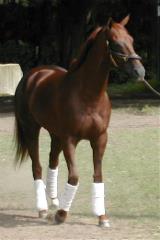Navicular Syndrome: What Clients Need to Know

Most clients can quickly recognize the early signs of lameness. While it is easy to tell that their animal is suffering, pinpointing the source of the pain can be difficult without the intervention of a veterinarian. While there are many attributable causes for equine lameness, when the problem is in the forelegs with pain arising from the hooves, the chance is good that the trouble will focus on the navicular bone and its surrounding tissues.
Navicular Syndrome
Navicular syndrome is the most common cause of intermittent foreleg lameness in horses. It is important that clients understand the disease and be aware of the treatment options when their animal is diagnosed. Responsible for nearly one-third of all cases of foreleg lameness, navicular syndrome is most commonly found in horses that are:
- Between 4 to 15 years of age
- Of various activity groups, for example:
- Sports-related activities where the animal is subjected to situations that cause front end impact, such as:
- Hard stops
- Abrupt changes in direction
- Forceful landings
- Work- or performance-related groups where the animal has increased opportunity for foreleg concussion, such as horses used for:
- Mounted police
- Trail riding
- Parade riding
- Carriage pulling
The breeds most diagnosed with navicular syndrome include:
- Quarter horse
- Thoroughbred
- Appaloosa
- Paint
- Warmblood
Cause
While there is no exact cause known for navicular syndrome, there are two factors that clients should be aware of that predispose their animal to navicular bone injury and pain:
- Poor foot conformation
- Infrequent hoof trimming
Abnormal conformation and inadequate hoof trimming can increase the tension and stress to the navicular bone and its supportive structures. Clients need to be aware of the importance of foot and hoof care to combat the occurrence of the degenerative changes that create the stress and tension that is thought to bring about navicular syndrome. Clients should know, but may need to be reminded, of the benefits of working with a skilled farrier in order to protect their horse from these types of damages.
Symptoms
Clients who pay close attention to their animals should be able to quickly determine the start of any hoof problems, but the symptoms of navicular syndrome are not always clear. Lameness caused by navicular syndrome may occur:
- Intermittently
- In either one or both front feet
- With slow progression
The pain caused by navicular syndrome is felt by the horse in the heel. Signs that indicate a horse is in pain may occur in such ways as:
- Stumbling
- Intermittent shifting from one foot to the other
- Gait and stride changes from smooth to stiff with a shortened, choppy stride
- Refusal to jump
- Landing toe first
Diagnosis
Clients who suspect navicular syndrome should immediately contact their veterinarian and request their animal be examined. There is no single test that can determine navicular syndrome. Diagnosis is made following a thorough veterinary examination which will include, but is not limited to:
- Gathering background and medical history of the horse
- Visual appraisal of the horse to gather information on such points as:
- At-rest examination that checks for:
- Conformation
- Balance
- Evidence of injury or stress
- Hands-on examination to check for:
- Any indication of injuries or stress, evident by:
- Pain
- Heat
- Swelling
- Blood vessel pulse of limbs
- Application of a hoof tester
- Observation of horse in motion to check for:
- Differences in gait
- Flexion tests
Treatment Methods
Until recently, the treatment of horses diagnosed with navicular syndrome has focused on methods such as:
- Therapeutic hoof trimming
- Corrective shoeing
- Regenerative medicine
- Pain management
- Nutraceuticals
- Surgery
- Shockwave therapy
Something New
Clients need to know that now there is an additional option. An advancement in the treatment of navicular syndrome comes following clinical study focused on a class of drugs currently designed for use in human medicine. The Federal Drug Administration (FDA) has approved bisphosphonate for veterinary use after study findings determined that this class of drugs effectively demonstrated control of the clinical signs of equine navicular syndrome.
Information to pass on to clients regarding the use of bisphosphonate in the treatment of navicular syndrome includes:
- Horse must be at least four years of age
- Medicine is only available for use by a veterinarian
- The treatment is given through an intramuscular injection in three separate sites, for example:
- Neck
- Pectoral muscles
- Gluteal muscles
- Animal is to be observed for two hours post-treatment for signs of reaction that could include, for example:
- Colic
- Agitation
- Cramping
- Hives
- If reactions are observed, client should contact their veterinarian and hand-walk the animal for 15 minutes or until the signs disappear.
Please attend the free webinar Bisphosphonates and the Control of Clinical Signs Associated with Equine Navicular Syndrome on December 3, 2015 from 2:00-3:00 PM EST. Webinar attendees are eligible to earn 1.0 hour CE credit. Register online now: http://bit.ly/decbis-b
Information gathered from:
http://www.dechra-us.com/files//dechraUSA/downloads/Client%20Literature/Osphos_client_brochure.pdf


Working Here
Our team members are encouraged to be the best they can be... at Covetrus we believe we impact one another.
Learn MoreNews & Events
FDA Cautions Pet Owners Not to Feed Texas Tripe Inc. Raw Pet Food Due to Salmonella, Listeria Monocytogenes
The U.S. Food and Drug Administration is cautioning pet owners not to feed their pets any of the Texas Tripe brand raw frozen pet food listed below because several samples of Texas Tripe raw pet food have tested positive for Salmonella and/or L. mono.
Careers
Are you looking for a place to let your talents shine? At Covetrus, we help our practitioner customers better serve their patients and take pride in providing the best customer experience possible. Search our open positions to see our available opportunities.
Newsletter
Stay current with what’s going on with Covetrus, subscribe to receive our newsletter and email communications. Subscribers will receive the latest information in practice management, sales and marketing, animal health, and more.



-3-(1).png?sfvrsn=2d806d73_0)

Leave a comment